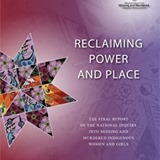As I continue to read the MMIWG Inquiry Final Report, I am impressed with the thoughtful language and, at the risk of over-simplification, want to help find a way to share the ideas with non-Indigenous Canadians like myself who may have unwittingly contributed to the problem.
The introduction spoke of genocide as the systemic destruction of Indigenous people as a nation and with it the sacredness of their women and girls.
Systemic dehumanization happened at many levels including political, social, cultural, economic, physical, and moral.
Forced assimilation deprived Indigenous people of their own power and created a marginalized society.
We need to create space for Indigenous people to reclaim their own values, power and place.
Section 1 – in four Chapters – speaks of Establishing a New Framework.
Chapter 1: Centering Relationships to End Violence.
The social context of racism, colonialism, and sexism produces conditions of systemic and targeted forms of violence and abuse against Indigenous women. (p.89) The last 150 or so years of history have negated the important roles, rights, and responsibilities held by Indigenous women and gender-diverse people in their own communities.
Relationships were essential to the Indigenous way of knowing – we are connected to ancestors, the land, and future generations. Relationships become “spaces of engagement” where attention is paid to attitudes and beliefs that run below the surface. We need to focus on voices previously ignored or silenced that knew about ending violence. (p.97)
Violence is described as the result of Intersectionality of overlapping oppressions. This means that violence is more likely to occur when discrimination is multiplied.
Four types of oppression are identified:
- (1) historical, multi-generational and inter-generational trauma from loss of land, forced relocation, residential schools, over-incarceration, etc.
- (2) social and economic marginalization evidenced by systemic poverty, homelessness, food insecurity, unemployment, barriers to education, etc.
- (3) status quo and institutional lack of will which individualizes systemic problems, and
- (4) ignoring the inherent expertise and agency of Indigenous women through media influence, lack of funding, and general disbelief.
Solutions need to be placed within these four root causes of violence and Women’s rights need to be recognized. (p.117) These include:
- Right to culture – inseparable from human rights,
- Right to health – including protection and mental health. Indigenous women held traditional roles as healers and medicine people.
- Right to security – Entire populations must have essential services such as health, housing, and access to water, food, employment, livelihood, and education.
- Right to justice – includes victim services, fair media coverage,
- Right to self-determination – Imposed solutions have not worked. Matriarchal tradition includes strong voices, resilience and healing. Indigenous women need authority to keep their own culture, make choices for their own group, and actively construct solutions that work.
We need to reconsider how to frame relationships that embrace full enjoyment of rights – reciprocal, renewing, and connected.
Indigenous women and girls are holders of rights as human beings and as Indigenous people. Relationships matter – they contribute to health or to harm. We need the opportunity to create something better and to improve outcomes. We must listen deeply to learn important information.


